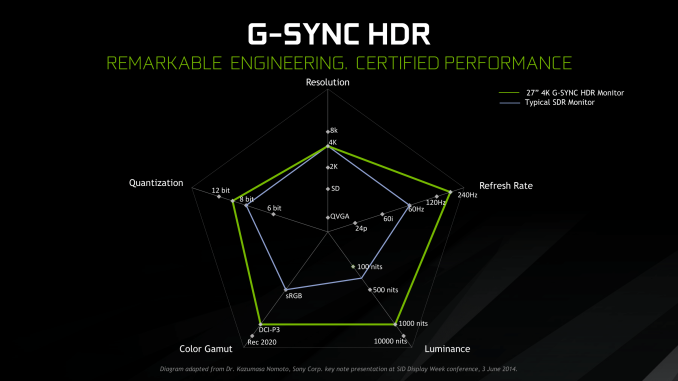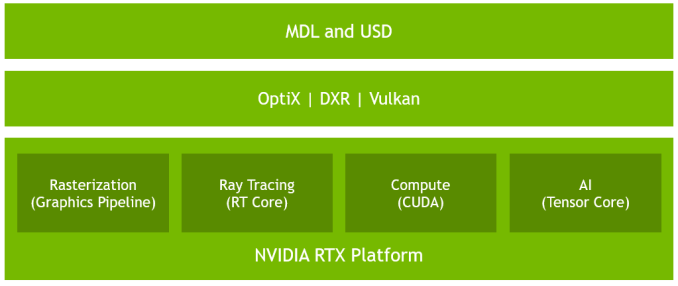The NVIDIA GeForce RTX 2080 Ti & RTX 2080 Founders Edition Review: Foundations For A Ray Traced Future
by Nate Oh on September 19, 2018 5:15 PM EST- Posted in
- GPUs
- Raytrace
- GeForce
- NVIDIA
- DirectX Raytracing
- Turing
- GeForce RTX
Meet The New Future of Gaming: Different Than The Old One
Up until last month, NVIDIA had been pushing a different, more conventional future for gaming and video cards, perhaps best exemplified by their recent launch of 27-in 4K G-Sync HDR monitors, courtesy of Asus and Acer. The specifications and display represented – and still represents – the aspired capabilities of PC gaming graphics: 4K resolution, 144 Hz refresh rate with G-Sync variable refresh, and high-quality HDR. The future was maxing out graphics settings on a game with high visual fidelity, enabling HDR, and rendering at 4K with triple-digit average framerate on a large screen. That target was not achievable by current performance, at least, certainly not by single-GPU cards. In the past, multi-GPU configurations were a stronger option provided that stuttering was not an issue, but recent years have seen both AMD and NVIDIA take a step back from CrossFireX and SLI, respectively.
Particularly with HDR, NVIDIA expressed a qualitative rather than quantitative enhancement in the gaming experience. Faster framerates and higher resolutions were more known quantities, easily demoed and with more intuitive benefits – though in the past there was the perception of 30fps as cinematic, and currently 1080p still remains stubbornly popular – where higher resolution means more possibility for details, higher even framerates meant smoother gameplay and video. Variable refresh rate technology soon followed, resolving the screen-tearing/V-Sync input lag dilemma, though again it took time to catch on to where it is now – nigh mandatory for a higher-end gaming monitor.
For gaming displays, HDR was substantively different than adding graphical details or allowing smoother gameplay and playback, because it meant a new dimension of ‘more possible colors’ and ‘brighter whites and darker blacks’ to gaming. Because HDR capability required support from the entire graphical chain, as well as high-quality HDR monitor and content to fully take advantage, it was harder to showcase. Added to the other aspects of high-end gaming graphics and pending the further development of VR, this was the future on the horizon for GPUs.
But today NVIDIA is switching gears, going to the fundamental way computer graphics are modelled in games today. Of the more realistic rendering processes, light can be emulated as rays that emit from their respective sources, but computing even a subset of the number of rays and their interactions (reflection, refraction, etc.) in a bounded space is so intensive that real time rendering was impossible. But to get the performance needed to render in real time, rasterization essentially boils down 3D objects as 2D representations to simplify the computations, significantly faking the behavior of light.
It’s on real time ray tracing that NVIDIA is staking its claim with GeForce RTX and Turing’s RT Cores. Covered more in-depth in our architecture article, NVIDIA’s real time ray tracing implementation takes all the shortcuts it can get, incorporating select real time ray tracing effects with significant denoising but keeping rasterization for everything else. Unfortunately, this hybrid rendering isn’t orthogonal to the previous concepts. Now, the ultimate experience would be hybrid rendered 4K with HDR support at high, steady, and variable framerates, though GPUs didn’t have enough performance to get to that point under traditional rasterization.
There’s a still a performance cost incurred with real time ray tracing effects, except right now only NVIDIA and developers have a clear idea of what it is. What we can say is that utilizing real time ray tracing effects in games may require sacrificing some or all three of high resolution, ultra high framerates, and HDR. HDR is limited by game support more than anything else. But the first two have arguably minimum performance standards when it comes to modern high-end gaming on PC – anything under 1080p is completely unpalatable, and anything under 30fps or more realistically 45 to 60fps hurts the playability. Variable refresh rate can mitigate the latter and framedrops are temporary, but low resolution is forever.
Ultimately, the real time ray tracing support needs to be implemented by developers via a supporting API like DXR – and many have been working hard on doing so – but currently there is no public timeline of application support for real time ray tracing, Tensor Core accelerated AI features, and Turing advanced shading. The list of games with support for Turing features - collectively called the RTX platform - will be available and updated on NVIDIA's site.













337 Comments
View All Comments
Gastec - Friday, September 28, 2018 - link
@cmdrdreddWatch out for those online scammers, you are in their target demographics ;)
Writer's Block - Monday, October 1, 2018 - link
always buy up-front.BurntMyBacon - Thursday, September 20, 2018 - link
@DigitalFreak: "He has a point. People are willing to pay $1000 for a phone, $1000 for a CPU, but $1000 for a high end graphics card is outrageous?"Fair point, but I tend to take the opposite approach and ask why people will pay more for a phone than a high end graphics card. ;')
Spunjji - Friday, September 21, 2018 - link
We're not having a fit over price, we're just not happy about it. A lot of people are digging deep to justify it, though, including making spurious arguments about the cost of things that have nothing to do with gaming GPUs. That strikes me as... not rational.$1000 phones are a great analogy, incidentally, but not for the reason you thought. It's another market area where manufacturers noticed people were sweating their assets for longer, so flimsy justifications were made for increasing the cost of entry to sustain margins. People buy it because they want it, not because it's good value.
Nvidia want to walk in here singing about a brave new world of Ray Tracing and then they tell me the cost to ride is $700+. To that I am saying nooooo thank you.
Does my not caring affect Nvidia much? No. But this is a forum, this is where we share opinions. Stop trying to act like only your opinion is rational and everyone else's is childish or misinformed.
Gastec - Friday, September 28, 2018 - link
I will NEVER pay €1000 for a smartphone. Unless of course ultra-inflation will....certainly happen in the next 15 years, when €300 now will be €1000 tomorrow. It has already started in the USA.godrilla - Wednesday, September 19, 2018 - link
Raytracing did you read the article ?Ranger1065 - Thursday, September 20, 2018 - link
Pathetic creature.Gastec - Friday, September 28, 2018 - link
@V900Soundeth like a true Avram Piltch's padawan :)
V900 - Wednesday, September 19, 2018 - link
BTW: Why do I get the distinct impression, that most of the people complaining about the price, would insist that it’s a totally fair and reasonable price, if this was an AMD graphics card?Qasar - Wednesday, September 19, 2018 - link
if this was an amd card.. it still would be too much, and i still wouldnt get one...